If you are searching for inch or Wandering Jew Plant Benefits then before that let me tell you it is a unique houseplant that is full of personality and a great choice if you’re new to gardening. In this blog post, we’ll take a closer look at the Inch plant (Wandering Jew), discussing its benefits, care instructions and growing guide. So grab your gardening gloves and let’s dive in! So What are inch plants good for?
The Tradescantia zebrina, Wandering Jew (Inch Plant) offers numerous benefits, including air purification, medicinal tea, antioxidant properties, good luck and ease of care. It’s a great choice for beginners due to its low maintenance requirements.
These plants prefer to have soils that are slightly acidic so if you decide to grow one indoors make sure they’re potted in a potting mix specifically made for acid-loving plants as well as perlite or vermiculite to provide additional drainage and aeration.
Wandering Jew plants do well fertilized with a balanced fertilizer every few weeks at about 1/4th strength throughout the growing season (May-September). Taper off fertilizing by fall as the days become shorter and cooler in order to prepare them for winter dormancy when growth will slow down.
Wandering Jew plants [2](inch plant) tend to be susceptible so spider mites or aphids from time-to-time so keep an eye out for any potential infestations of these pests and treat appropriately with insecticidal soap.
if necessary Be on the look out for signs such as brown spots on the leaves which could indicate sunburn because you want your plant displayed in indirect light rather than direct sunlight exposure in order to avoid stressing out your plant too much which could lead it into decline.
Trimming off any damaged leaves is also advised because this will allow the plant more nutrients it needs make new healthy growth faster without expending those resources into unhealthy areas.
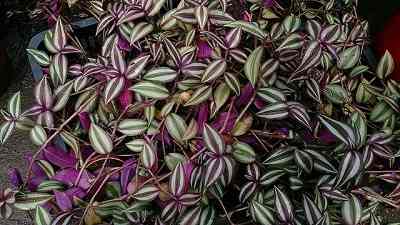
About Wandering Jew
Inch plant (Wandering Jew) also known by its scientific name Tradescantia zebrina, are beautiful, trailing houseplants that look great in hanging baskets or on shelves. The foliage of these plants is a purplish-green in color and can occasionally display white stripes. They prefer dry soil and cool temperatures.
When caring for Inch plant (Wandering Jew) it is important to make sure that your plant has plenty of indirect sunlight and ample drainage. When it comes to watering these plants, aim for moist but not soggy soil as this can lead to root rot. If you’re growing a wandering jew outdoors, water them regularly every couple of days during periods of hot weather or drought.
Inch plant (Wandering Jew) are toxic to pets that most Americans have, like dogs and cats. That is why the pet owner needs to be extra careful when growing them. Many people get confused with why you should be growing these plants if they are sensitive? so the answer is they have so many benefits that can make you say YES for wandering jew. I have mentioned all the benefits and if you and someone you know have these beautiful plants then they should definitely know and you should also get one.
Purify Air
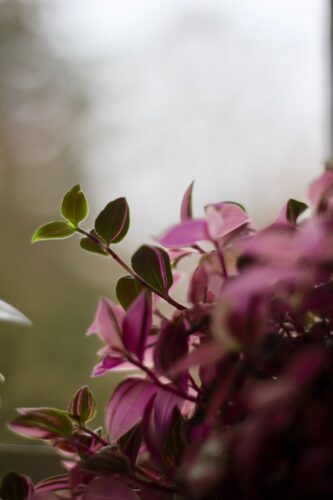
Inch plant (Wandering Jew) also known as Tradescantia zebrina, have become popular due to their attractive, exotic foliage. Its attractive oval-shaped leaves can come in silvery, purple and green shades. This hardy and easy-to-care for plant also has hundreds of small purple, white and pink flowers which form along the length of wiry stems that can reach a height of up to three feet.
Not only are Inch plant are beautiful to look at but they can also help purify the air indoors. They give off oxygen, absorb pollutants and reduce allergenic dust mites in indoor spaces; this makes them an ideal choice for improving the quality of air indoors. According to alive, this houseplant reduces benzene, TCE, toluene, and terpenes. Also it is added in top 12 plants list that purifies air according to apieceofrainbow.
Medicinal uses
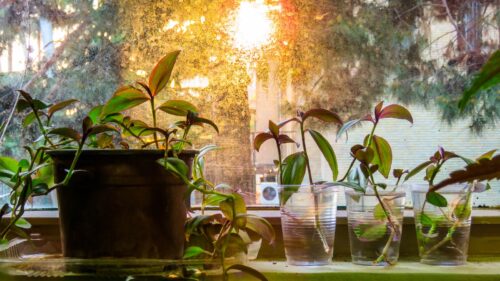
To access the medicinal benefits of the Wandering Jew plant, the leaves and stems are typically used. Depending on the desired use, the plant may be prepared in a variety of ways, including decoctions, infusions, and teas. The Wandering Jew plant provides a variety of chances for fostering general health and wellbeing thanks to its rich nutritional profile and medicinal ingredients.
The Wandering Jew plant has a wealth of antioxidants, which is one of its most important health advantages. Antioxidants are essential for scavenging dangerous free radicals from the body and shielding cells from oxidative stress. These antioxidants are essential for avoiding a number of illnesses and preserving general health. The Wandering Jew plant may help your body fight inflammation and oxidative damage, so include it into your routine as much as possible.
The Wandering Jew plant has long been used to treat conditions linked to inflammation and infections. Due to its anti-inflammatory characteristics, it is a useful natural treatment for ailments including nephritis, urinary infections, and leucorrhea. Additionally, its antimicrobial function aids in preventing the growth of dangerous microorganisms and supports a strong immune system.
The Wandering Jew plant’s decoction has been recommended as a therapy to improve kidney function in Malaysia. This medical application is important in particular because it could help maintain healthy kidney function and guard against kidney-related diseases. The plant’s advantages also apply to the urinary system, where it may aid in the treatment of urinary infections.
The Wandering Jew herb may have antiarrhythmic qualities, according to studies. These characteristics are useful for controlling irregular heartbeats and enhancing cardiovascular health. However, further investigation is required to completely comprehend and use this potential advantage.
Health Benefits
The Inch plant (Tradescantia zebrina) are a great addition to any home or office. This low maintenance plant has numerous benefits that make it desirable to own. In particular, the plant has great health benefits that can improve the air quality in your home.
One of the great health benefits of owning a Wandering Jew plant is its ability to absorb toxins from the environment around your home. This can reduce the concentration of dangerous pollutants and bacteria in the air, providing a healthier atmosphere for you and those around you. This is especially helpful for those who suffer from allergies or breathing difficulties.
In addition to its ability to purify the air, owning a Wandering Jew plant can also help reduce stress levels and certain illnesses such as headaches and chest pains. Wandering Jew plants give off an aroma similar to peppermint when they blossom, which can act as a mild nerve relaxant, thus reducing stress levels considerably.
The presence of Wandering Jew plants in one’s home not only improves air quality but also makes it more aesthetically pleasing with its thick white leaves and contrasting dark purple tips that move gracefully with any slight touch or hint of wind. They are very easy to care for as they require very little light and water, making them ideal for people with busy lives or who lack gardening experience.
To sum up, there are many reasons why one should consider owning a Wandering Jew plant (Tradescantia zebrina). Not only do these plants boost indoor air quality by absorbing pollutants from their surroundings, but they also give rooms an aesthetically pleasing touch with their white leaves and attractive purple tips that move gently when touched or exposed to breeze. Furthermore, caring for these plants requires very little effort on behalf of owners as they require minimal amounts of light and water which makes them suitable even for first time gardeners or those with busy lifestyles.
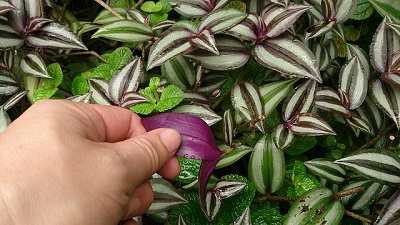
Easy Propagation
What sets Wandering Jew distinct is its astonishing capacity for easy reproduction. It is a superb selection for plant lovers of all levels since anybody can produce new plants from the parent Wandering Jew with only a basic pair of scissors and some basic understanding.
The Art of Propagation
Taking cuttings from an established, healthy plant is the key to growing the Wandering Jew. Beginners have a great chance to explore the world of plant propagation via this simple procedure. Listed below is a step-by-step instruction on how to spread the Wandering Jew:
1. Compiling the Resources
Collect the required ingredients and start the propagation process. If you want to propagate in water, you will also need a clean container or vase filled with water, a sharp set of scissors, and wet potting soil. To get clean cuts that will aid in effective roots, make sure your scissors are sharp and clean.
2. Cutting the Branches
Recognize robust stems that have at least one leaf node. Just below a node, cut pieces between 1 and 2 inches long with your scissors. Make sure each cutting contains at least one leaf node since nodes are necessary for the growth of roots. To get the best results, think about taking many cuttings.
3. Pond Propagation
If you decide to grow your Wandering Jew in water, put the cuttings into the vase or clean container. Make sure the leaf node is underwater and the remainder of the cutting is above water. You should see roots forming after a few weeks if you place the container in an area with strong indirect light.
4. The Spread of Soil
If soil propagation is your preference, prepare a wet potting mix in a spick-and-span container. Make careful to cover the leaf node while planting the cuttings in the ground, leaving the remaining portion of the cuttings above the soil line. Maintain stable soil moisture levels and place the container in an area with indirect light. You’ll see the establishment of robust root systems over time.
Guides to Success
Although spreading the Wandering Jew is a very simple operation, following a few recommendations may increase your success rate:
1. Timing
The Wandering Jew spreads best in the spring and early summer. The plant is in its active development phase at this time, which encourages a speedier and better roots process.
2. Thermostat:
Keep your cuttings in a warm area so they can grow. The best temperature range for promoting root development is 70°F to 80°F (21°C to 27°C).
3. Moistness:
Cuttings of wandering Jews like high humidity. By frequently spraying the cuttings or enclosing them in a clear plastic bag, you may increase humidity.
4. Resilience:
Be patient; propagation takes time. Your cuttings may take several weeks or even a month to form roots and become independent plants.
Inch plant (Wandering Jew) are also incredibly easy to propagate annually using setting off new growth from existing plants, meaning you can own more than one without having to purchase multiple! All that needs to be done is snipping off bits of existing branches and replanting them in other pots or outdoors depending on where you live climatically – much easier than having buy them every year! So brighten up your decorations with this colourful beauty while making sure it remains thievingly healthy – what could be better?
Low-Maintenance
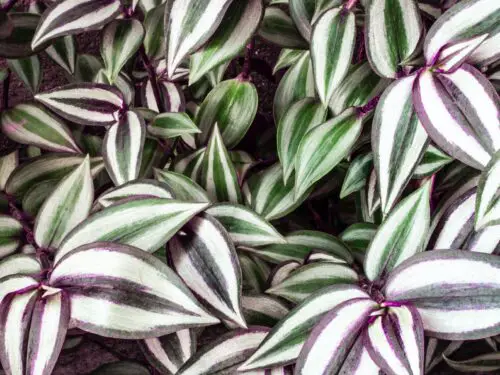
Wandering jew is a low maintenance plant and here are the tips to make it grow comfortably :
Selecting the Proper Location and Temperature
Selecting the proper location for your Wandering Jew plant is crucial to ensuring its best development. All year long, these plants like temperatures between 50 and 80 °F (10 and 27 °C). Because of this, be careful to choose a spot in your house that is within this temperature range.
Choosing the Ideal Pot
Choose a container with drainage holes that is about 12 inch (1.3 cm) larger than the root ball for your Wandering Jew. Good drainage is essential for the health of your plant, whether you choose a hanging basket or a standard gardening pot with a saucer.
Your Wandering Jew’s Potting
It’s time to pot your Wandering Jew plant after choosing the right container. Start by adding light, well-draining potting soil until the container is approximately two thirds full. After that, carefully set the plant in the middle of the container, making sure the earth is covering the roots completely. This step is crucial for giving your plant a steady habitat so that it may develop and thrive.
Moisture and Watering Levels
Keeping your Wandering Jew at the proper moisture level is essential for their wellbeing. These plants don’t like too dry soil and prefer to get frequent irrigation. In order to prevent root rot, keep the soil uniformly wet but watch out to avoid making it soggy. Water your plant when the top 1/2 inch of the soil feels dry to the touch, as a general guideline.
For Optimal Growth, Pruning
It’s not only simple to prune your Wandering Jew, but it’s also good for its development and look. Although these plants don’t need heavy pruning, pinching off the tips may reduce the plant’s size and encourage bushier growth. Your Wandering Jew will look its best if you regularly clip any leggy or discolored stems.
Requirements for light
Wandering Jew plants like direct, strong light. Find a location in your house where your plant can get enough of light without being in full sunshine, which might result in leaf scorching. Ideal locations include a room with a window that is screened by a curtain or a space that is a little distant from a window that faces south.
Considerations for Fertilizing
It’s recommended to avoid overfertilizing your Wandering Jew in order to preserve its low-maintenance nature. These plants may live without fertilizer on a regular basis. For at least the first two months after potting your plant, skip fertilizing. After that, throughout the growth season, a diluted, balanced liquid fertilizer applied once every two to four weeks should be enough.
Simple nature
The Vagrant Jew’s laid-back personality makes it a desirable addition to any interior area. Your Tradescantia zebrina should flourish for many years if you give it enough light, maintain the correct humidity levels, and sometimes trim to promote bushier growth.
Visually Appealing
According to nbcnews, indoors plant can improve your health and mood which result in overall happiness.
Inch plant (Tradescantia zebrina) are one of the most popular houseplant varieties available. This relatively inexpensive and aesthetically pleasing plant is also extremely easy to care for, even in the hands of a novice gardener.
Their distinctive variegated and striped foliage is arguably their biggest draw, adding eye-catching appeal to any room in your home or office. The plant’s bright purple leaves with silver markings can be remarkable when placed in full sun near a window. Wandering Jew (inch plant) are beautiful and unique plants can quickly become very popular among both amateur and expert gardeners alike as they adapt readily to indoor conditions.
In addition to being relatively inexpensive, Wandering Jews are some of the most forgiving houseplants when it comes to care requirements. They’re quite tolerant of mild neglect, making them a great choice for those who don’t have time to take too much attention out of their schedule for plant-keeping. With the right amount of good indirect light and infrequent watering’s or misting’s, this low maintenance plants are sure to attract attention wherever you have them placed!
Beautiful Plants
Charming and with a unique appearance, Inch plant (Wandering Jew) have become indispensable house plants for many gardeners. Coming from the Tradescantia family, these colorful beauties are carefree and quite easy to propagate.
The tricolor foliage of Wandering Jew plants adds an interesting touch to any interior decor with their popular zebra-stripe pattern. Colors vary between bright green, dark purple/green, and silvery green/purple making it a color palette you won’t easily forget! These are also very low maintenance plants so even if you don’t think you have a green thumb, this one is doable!
benefits of wandering jew is that it can be easy to take care of as they are beautiful, the care for the Wandering Jew plant is uncomplicated. As long as they get plenty of sunlight like spotty filtered light or partial shade and water regularly they will thrive. If they’re in darker parts of your home then try misting them once in a while as well or consider investing in some LED lights that mimic daylight to help it keep growing. Make sure not to overwater either because this can lead to root rot and lead to other complications such as fungus gnats if there’s an accumulation of moisture around the roots for too long.
Decorative Options
When it comes to low-maintenance, easy-to-care-for houseplants, Wandering Jew (inch plant)(Tradescantia Zebrina) are at the top of the list. Native to Mexico and sometimes referred to as an inch plant[3] or a spiderwort, these plants are the perfect choice for both novice and experienced gardeners. As a bonus, decorating ideas with wandering jew plants are nearly endless.
Wandering jew plants or Inch plant can be used in a variety of ways to create stunning displays indoors and out. When it comes to the outdoors, the options are near limitless for cute container gardens or full landscapes that include an array of blooms and foliage. Indoor use is just as popular; you’ll find wandering jew in everything from hanging baskets to window boxes.
This plant is also an excellent choice if you’re looking for a creative way to hide unpleasant views or brighten up outdoor spaces; its spaghetti-like stems can add texture and beauty in unexpected places like unsightly fences or a dull corner of your yard. It’s also great for filling in gaps along walls or staircases with its cascading foliage further accenting these spots with color and texture.
The delicate leaves make an excellent contrast against wooden elements like tree stumps, window frames or shelves; its fringed creeping habit make it perfect for creating ivy alternatives around pergolas or even covering exterior shed walls! For those who want something more whimsical consider combining wandering jew(Inch plant) with flowers making it look like it’s climbing up them! Whether you’re adding an airy texture indoors or creating incredible eye-catching pieces outside decorating ideas with Wandering Jews plants are nearly endless!
Wandering Jew Tea
In Guyana, the leaves of the Wandering Jew plant are brewed into a tea to treat influenza and cleanse the blood. They are also used to cure digestive issues. Similarly, in Malaysia, the Wandering Jew leaves are used to make tea and treat various health problems, including high blood pressure and tuberculosis.
The Wandering Jew plant also plays an important role in traditional treatments in Malaysia. This plant’s leaves are used to make a medicinal tea that has a number of positive health effects. This tea is particularly well-known for its effectiveness in treating TB and high blood pressure. The leaves go through a meticulous preparation procedure that entails boiling them together with other all-natural components like red dates and ginger. This mixture has a reputation for having the ability to improve general wellbeing and ease health issues.
The Wandering Jew, also known as Tradescantia zebrina in scientific jargon, has a long history of use in herbal therapy. In addition to making tea, you may also make a compress or a decoction using the leaves. It is claimed that these remedies may effectively cure a number of conditions, including high blood pressure. The plant’s history of use in conventional cold remedies also illustrates how adaptable it is when it comes to dealing with various health issues.
Beyond its usage as a herb for health purposes, the Wandering Jew plant is easy to grow. Because it is quite simple to cultivate and manage, anybody who wants to take advantage of its health advantages may do so. If given the proper care and attention, it will flourish, and choices like compost tea or all-purpose fertilizers may support this.
Why Wandering Jew Plants Are Good for Homes?
the Wandering Jew (inch plant) is also an good and ideal companion for those looking for effortless houseplants with low care requirements — making it great choice if you don’t have too much time to dedicate towards gardening! It’s also easy to propagate thanks to its prolific nature making it ideal choice if you have younger family members caring for them[4].
A Wandering Jew as Feng Shui Plant?
In feng shui living, Areas filled with Wandering Jew (inch plant) life invite positive energy and creates inviting atmosphere which helps improve overall wellbeing of your home so having Wandering Jew Plants around always beneficial regardless of whether you personally superstitious or not! Many choose place these plants silently corners pairing them intriguing dark furniture pieces while other pick draw attention by positioning pot center stage accenting colorful room decors though both options equally good depending on personal preference – key thing make sure observe changes maybe gone unnoticed such health condition leaves over time address them quickly possible increase life span enjoying greens even longer [5]!
How Do Wandering Jew Plants Grow?
To get the most out of your Wandering Jew (inch plant)plant & to grow them well make sure to give it plenty of indirect sunlight throughout the day — this will help maintain its vibrant hues! When watering, ensure soil medium remains moist but not soggy as too much water will eventually lead soil wetting and putting off roots resulting in rotting; keeping excess water away should be priority year round as especially during winter when photosynthesis activity slows down dramatically. To keep your wandering jew healthy all year long place pot in sunny location rather than draughty window or door where temperature vary drastically which can put lot of stress on these fragile looking plants but many benefits feng shui wise!
Wandering Jew plant varieties
Wandering Jew (inch plant) come in three varieties – Zebrina or Wandering Jew, Purple Heart (Setcreasea pallida), and Inch Plant (Tradescantia fluminensis). The Zebrina variety has purplish-green leaves with silvery bands and dots on them, while Purple Heart has deep purple leaves with velvet finish on them. The Inch plant has small dense leaves that are bright green covered with silver to gray patches or stripes; here each leaf appears like an inch in length. All these species tend to be densely matted when grown in masses but can even sprawl when allowed room for growth in well draining containers or moss baskets.
All three varieties of these low-maintenance plants prefer moist soil but should never be allowed to stand in soggy soils for too long as this leads to root rot.When it comes to planting requirements, all you need is rich soil mixed with perlite and peat moss for added drainage facility, partial sun or indirect light conditions along with a potting mix for the container gardening variety. Moreover, all the varieties enjoy regular watering during summer months but avoid overwatering during winter season because it will rot those fuzzy roots that are essential for proper growth of any plant species within this genus group!
Wandering Jew Plant Vastu
Inch plant or Wandering Jew should be placed in the northeast or northeastern spot of the house according to Vastu. This spot is believe to provide the plants good vibes for the family. The Wandering Jew should can face the house entrance that would also bring good luck, calm and peace indoors.
Vastu includes much than just the Wandering Jew. Energy should flow naturally through the house, for instance. Balanced and symmetrical, the home should face the cardinal directions. To produce positive energy, the home should be clean and clutter-free and decorated in calming hues.
Wrap Up
I hope you get all the information about “Wandering Jew plant benefits” and if you like to read about this plant below you can check.
How to Prune Wandering Jew – Tradescantia Cutting Guide
The Symbolism of the Wandering Jew Plant
The Use of Wandering Jew Plants in Feng Shui
8 Types of Wandering Jew & Care Tips (Tradescantia Varieties)
History of the Wandering Jew Plant
Reference :
University of Wisconsin-Madison Division of Extension – Tradescantia zebrina
University of South Florida – Tradescantia zebrina
